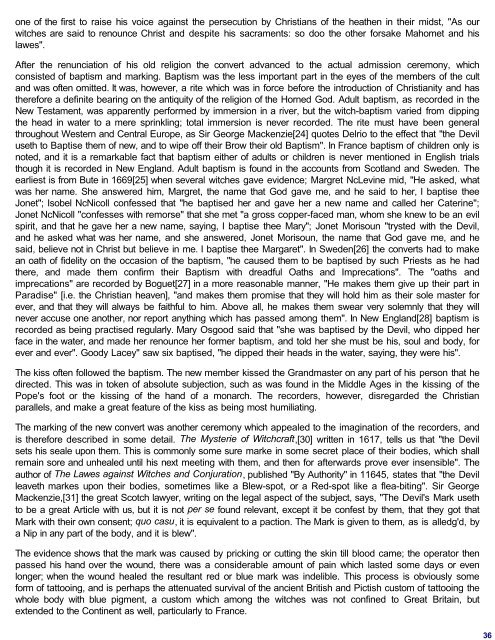THE GOD OF THE WITCHES - World eBook Library - World Public ...
THE GOD OF THE WITCHES - World eBook Library - World Public ...
THE GOD OF THE WITCHES - World eBook Library - World Public ...
Create successful ePaper yourself
Turn your PDF publications into a flip-book with our unique Google optimized e-Paper software.
one of the first to raise his voice against the persecution by Christians of the heathen in their midst, "As our<br />
witches are said to renounce Christ and despite his sacraments: so doo the other forsake Mahomet and his<br />
lawes".<br />
After the renunciation of his old religion the convert advanced to the actual admission ceremony, which<br />
consisted of baptism and marking. Baptism was the less important part in the eyes of the members of the cult<br />
and was often omitted. It was, however, a rite which was in force before the introduction of Christianity and has<br />
therefore a definite bearing on the antiquity of the religion of the Horned God. Adult baptism, as recorded in the<br />
New Testament, was apparently performed by immersion in a river, but the witch-baptism varied from dipping<br />
the head in water to a mere sprinkling; total immersion is never recorded. The rite must have been general<br />
throughout Western and Central Europe, as Sir George Mackenzie[24] quotes Delrio to the effect that "the Devil<br />
useth to Baptise them of new, and to wipe off their Brow their old Baptism". In France baptism of children only is<br />
noted, and it is a remarkable fact that baptism either of adults or children is never mentioned in English trials<br />
though it is recorded in New England. Adult baptism is found in the accounts from Scotland and Sweden. The<br />
earliest is from Bute in 1669[25] when several witches gave evidence; Margret NcLevine mid, "He asked, what<br />
was her name. She answered him, Margret, the name that God gave me, and he said to her, I baptise thee<br />
Jonet"; Isobel NcNicoll confessed that "he baptised her and gave her a new name and called her Caterine";<br />
Jonet NcNicoll "confesses with remorse" that she met "a gross copper-faced man, whom she knew to be an evil<br />
spirit, and that he gave her a new name, saying, I baptise thee Mary"; Jonet Morisoun "trysted with the Devil,<br />
and he asked what was her name, and she answered, Jonet Morisoun, the name that God gave me, and he<br />
said, believe not in Christ but believe in me. I baptise thee Margaret". In Sweden[26] the converts had to make<br />
an oath of fidelity on the occasion of the baptism, "he caused them to be baptised by such Priests as he had<br />
there, and made them confirm their Baptism with dreadful Oaths and Imprecations". The "oaths and<br />
imprecations" are recorded by Boguet[27] in a more reasonable manner, "He makes them give up their part in<br />
Paradise" [i.e. the Christian heaven], "and makes them promise that they will hold him as their sole master for<br />
ever, and that they will always be faithful to him. Above all, he makes them swear very solemnly that they will<br />
never accuse one another, nor report anything which has passed among them". In New England[28] baptism is<br />
recorded as being practised regularly. Mary Osgood said that "she was baptised by the Devil, who dipped her<br />
face in the water, and made her renounce her former baptism, and told her she must be his, soul and body, for<br />
ever and ever". Goody Lacey" saw six baptised, "he dipped their heads in the water, saying, they were his".<br />
The kiss often followed the baptism. The new member kissed the Grandmaster on any part of his person that he<br />
directed. This was in token of absolute subjection, such as was found in the Middle Ages in the kissing of the<br />
Pope's foot or the kissing of the hand of a monarch. The recorders, however, disregarded the Christian<br />
parallels, and make a great feature of the kiss as being most humiliating.<br />
The marking of the new convert was another ceremony which appealed to the imagination of the recorders, and<br />
is therefore described in some detail. The Mysterie of Witchcraft,[30] written in 1617, tells us that "the Devil<br />
sets his seale upon them. This is commonly some sure marke in some secret place of their bodies, which shall<br />
remain sore and unhealed until his next meeting with them, and then for afterwards prove ever insensible". The<br />
author of The Lawes against Witches and Conjuration, published "By Authority" in 11645, states that "the Devil<br />
leaveth markes upon their bodies, sometimes like a Blew-spot, or a Red-spot like a flea-biting". Sir George<br />
Mackenzie,[31] the great Scotch lawyer, writing on the legal aspect of the subject, says, "The Devil's Mark useth<br />
to be a great Article with us, but it is not per se found relevant, except it be confest by them, that they got that<br />
Mark with their own consent; quo casu, it is equivalent to a paction. The Mark is given to them, as is alledg'd, by<br />
a Nip in any part of the body, and it is blew".<br />
The evidence shows that the mark was caused by pricking or cutting the skin till blood came; the operator then<br />
passed his hand over the wound, there was a considerable amount of pain which lasted some days or even<br />
longer; when the wound healed the resultant red or blue mark was indelible. This process is obviously some<br />
form of tattooing, and is perhaps the attenuated survival of the ancient British and Pictish custom of tattooing the<br />
whole body with blue pigment, a custom which among the witches was not confined to Great Britain, but<br />
extended to the Continent as well, particularly to France.<br />
36















